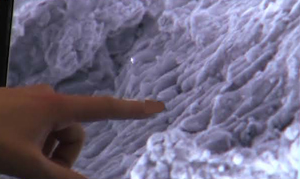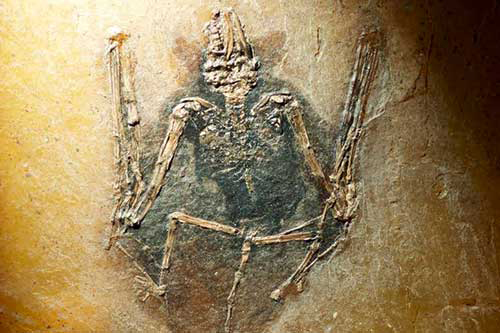Bat Study Helps to Confirm Melanosome Detection in Fossils
Melanin is a very widespread, natural pigment found in the animal kingdom. Different forms of melanin are responsible for the colour of organisms, the black and the brown/reddish hues, for example. Over the last few years, studies have attempted to identify evidence of melanosomes (the specialised part of the animal cell which synthesises, stores and transports the pigment), within the fossil record, but why is the search for an understanding about the colour of long dead creatures so important?
Colour Holds Key to Behaviour
In living animals today, colour patterns are closely linked to behaviours and colouration provides information on how these creatures interact with their environments. From the ornate and beautiful peacock to the striking pigmentation of an okapi, knowledge of the colour of an organism provides scientists with a host of information.
If only we had such insights for long extinct animals, well we do, but the identification of preserved melanosomes in the fossil record has proved controversial. The interpretation of the structures found has led to some very colourful debates. Are scientists able to infer pigmentation from these preserved remains?
Shapes of Structures Seen Under Very High Magnification Can Provide a Clue to Original Colour
Even the Dinosauria has been dragged into the discussion, back in 2010, Everything Dinosaur reported on research led by Bristol University that attempted to identify the colour of feathers preserved in the fossils of a little Chinese theropod dinosaur Sinosauropteryx.
To read more about this research: A Ginger Dinosaur.
Newly Published Paper
Now a new paper produced by scientists from the University of Bristol in collaboration with colleagues from Virginia Tech and a number of other American academic institutes, backs the earlier research suggesting that the chemical preservation of melanin is possible within the fossil record. The scientists studied a range of exceptionally well-preserved vertebrate fossils including specimens dating back to the Carboniferous and much more recent fossil material, the bats from the Early Tertiary shales of Messel in Germany, for example, along with some even more recent Miocene fossils.
The team were able to show that melanin is preserved in a number of soft-bodied fossils, but its burial under high pressure and temperature, all part of the fossilisation process does alter its original chemistry. Other scientists had proposed that the structures thought to be melanosomes preserved in the fossil record, were actually bacteria that had become part of the fossil structure as they preserved the bacterial action of the original organic remains decomposition. The research team concludes that the relatively widespread occurrence of melanin found allows them to dismiss the suggestion that these structures are microbial in origin.
Are We Closer to Determining the Colour of Dinosaurs?
Dr Jakob Vinther (Bristol University), one of the authors of the paper published in the PNAS (Proceedings of the National Academy of Sciences – America), replicated the conditions under which fossils form and then subjected the samples to analysis using extremely sensitive ion mass spectroscopy (TOF-SIMS – time-of-flight ion mass spectroscopy), the scientists were able to map how the melanin chemical composition would change over time and then compared their results to what was found in a chemical analysis of the fossil record.
Dr Vinther stated:
“This is a great leap forward in our understanding of how fossils are preserved. We now know how melanin is preserved and we have the methods to confidently detect it.”
In short, if scientists now know how the pigment behaves during fossilisation and what its chemical signature should be after the fossilisation process has occurred, then they should be able to identify melanin in fossils by looking for this tell-tale signature.
Two Distinct Types of Melanin
There are two distinct types of melanin, eumelanin is responsible for the colour black and these structures resemble tiny sausage shapes when examined under high magnification. The second type, responsible for the reddish/brown hues is phaeomelanin and its structures look much more circular when viewed under a microscope. Importantly, structures which resemble these shapes have been spotted in the fossil record, as they have different chemical signatures, a chemical analysis can be used to back up observations regarding observed melanin structures.
Everything Dinosaur stocks a wide range of colourful prehistoric animal models including a replica of a feathered dinosaur: CollectA Prehistoric Life Models.
Prehistoric Bats Under the Spotlight
Take for example, those prehistoric bat fossils from the Messel shales which date from the Eocene Epoch. Two species were studied and microscopic analysis of the beautifully preserved fur showed shapes that looked like the more circular structures associated with phaeomelanin (reds and browns). The time-of-flight ion mass spectroscopy confirmed this interpretation.
Chemical signatures found support the idea that those circular structures would have meant that when these bats lived some fifty million years ago, the bats would have been reddish-brown in colour. By using the morphological analysis backed up by the chemical signature study, the team could conclude with a high degree of certainly that these two species of bat were effectively brunettes.
A Fossil Bat – Palaeochiropteryx (Messel, Germany) from the Study
Picture credit: Dr Jakob Vinther
The Colour of Dinosaurs
Also involved in this study were scientists from the University of Texas at Austin (Texas), along with Caitlin Colleary, who had done his Masters Degree at Bristol University but was now a PhD student at Virginia Tech.
Outlining the extent of their study, Caitlin said:
“We have now studied tissues from fish, frogs, and tadpoles, hair from mammals, feathers from birds, and ink from octopus and squids. They all preserve melanin, so it’s safe to say that melanin is all over the place. Now we can confidently fill in some of the original colour patterns of these ancient animals.”
This area of research is likely to remain controversial for a while longer. So much depends on how we interpret the morphology of these tiny structures. This research does provide a chemical method of helping to back up findings, however, we suspect that the debate amongst scientists will rumble on. After all, in scientific research of this nature, hardly anything is as clear as black and white.
More research into the colour of dinosaurs (August 2015): The Colour of Dinosaurs.
Dinosaurs may have laid coloured eggs (May 2015): Did Dinosaurs Lay Coloured Eggs?
Working out the colour of dinosaurs may have become a little more complicated: Working out the Colour of Dinosaurs Just Got Harder.
The colour of marine reptiles: Marine Reptiles and their “Little Black Numbers”.
Everything Dinosaur acknowledges the help of Bristol University in the compilation of this article.







